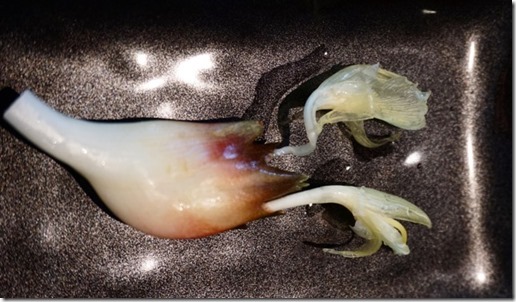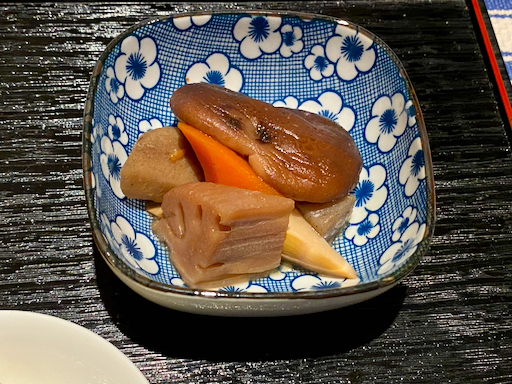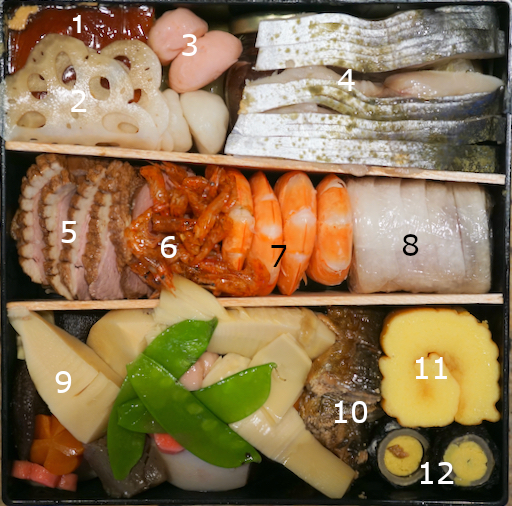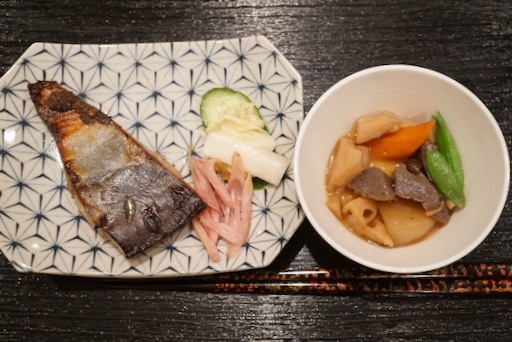Wednesday, November 15, 2023
Simmered “Shirataki” Konjac Noodle and Deep-fried Tofu しらたきと油揚の煮物
Ingredients:
1/3 package (about 100 grams) of “shirataki”, washed, boiled, washed again and cut into convenient length
1 small carrot, peeled and julienned
1 abura-age, hot water poured over (to thaw and remove excess oil), water squeezed out and then cut into thin threads
1 scallion finely chopped
300 ml Japanese dashi broth
30 ml sake
15 ml mirin
20 ml soy sauce (I used x4 concentrated Japanese noodle sauce)
Directions:
Add, the shirataki, carrot, and abura-age in a pot add the broth and cook for 5-10 minutes.
Add the seasonings and cook until the liquid is reduced by 1/3.
The original recipe calls for sugar but I did not add it. Japanese noodle sauce does have some sweetness which compensated for not having any sugar. This could be a side dish for rice but it is also perfect for a drinking snack.
Friday, March 3, 2023
Sukiyaki Made with Beef and Edible Chrysanthemum from Weee すき焼き
Recently, we started getting Asian groceries from Weee, and found a leafy green vegetable called “Tang Ho 茼蒿, chrysanthemum green”. In addition, I also found they had a product called “Little Sheep Marbled Beef Sliced for Hot Pot”. So we got both to try them for sukiyaki. The package indicated the beef was sold by a company called Little Sheep Company (子羊). We learned that this company runs Mongolian hot pot chain restaurants and also sells meat like the one we just got. The Chinese writing on the package indicated the meat was “Wagyu 和牛” or Japanese beef but did not indicate what country the meat actually came from. Nonetheless it was just the right thickness for sukiyaki and had some marbling, (although not as much marbling as shown in the Weee website picture).
*Although spinach can be substituted for edible chrysanthemum it does not have the unique flavor which characterizes shungiku and is such an integral component of the sukiyaki taste experience. Shungiku is relatively easy to grow from seeds and we were able to raise it for some years in our herb garden. Then the rabbits discovered they liked it too. They ate not only all the edible mum out of the herb garden but every other chrysanthemum related plant we had in the yard edible (for us) or not. As a result we have not been able to raise mums of any kind.
*Thread form of konnyaku, washed and blanched and cut into shorter segments.
For the chrysanthemum green, I removed the leaves from the stem, washed and blanched them. Although the plant looked slightly different it tasted exactly like Japanese “shungiku”.
Using these ingredients we had sukiyaki using a cast-iron sukiyaki pot and our new table-top induction cooker. The seasonings were my usual sugar, soy sauce, and sake (Kansai style 関西風) as opposed to using the premixed seasoning liquid “warishita” 割下 (Kanto style 関東風).
Sunday, January 30, 2022
Octopus rice 瀬戸内海蛸めし
We have been getting Japanese rice from the New York Rice factory. It may be hard to believe (we our selves are somewhat incredulous) that there could be such a difference in something as subtly flavored as rice but the rice from the rice factory is really good. It is hard to identify what sets it apart from the rice we used to get but in general we really like the texture, the taste and especially how well it can be reheated and still tastes like it just came out of the rice cooker.
Whenever I order rice from the rice factory I usually supplement the order with other items. In the past, we got a kit to make “red snapper rice” or “taimeshi” 鯛めし, a type of seasoned rice famous in the Japanese inland sea area or "seto-naikai" 瀬戸内海. Another time I ordered a similar seasoned rice kit made with octopus called “seto-naikai tako-meshi” 瀬戸内海蛸めし. After I bought it, however, the kit sat in our pantry for some time. When I checked the expiration date, it had expired the previous month, so I decide it was time to make it as a shime 〆 or ending dish one weekend. The kit came in several pouches; one with seasoning sauce, one with small bits of octopus, one with freeze dried items. It also included a rectangle of kelp. I made the octopus rice according to the instructions. I served it with a side of simmered Japanese root vegetables I had made and salted cucumber, daikon and nappa cabbage or "oshinko" お新香.
Sunday, December 26, 2021
“Shoga-yaki” ginger pork bowl “tei-shoku” lunch 豚の生姜焼き丼定食
A few weeks ago, my wife suggested that it has been quite a while since we had sukiyaki すき焼き and it would be nice to have some. I agreed, but when I went to the Japanese grocery store, I forgot to get the frozen "Sukiyaki meat" すき焼肉. So, the next time I went I was proud of myself for not forgetting the meat. But apparently I picked up the wrong thing. My first clue was when my wife said, “I didn’t know sukiyaki is made with pork, I thought it was beef.” Instead of sukiyaki beef, in my haste I had picked up thinly sliced pork for "shouga-yaki" 生姜焼き. Since this package was next to the "shabu-shabu" シャブシャブ beef, I assumed it was also beef but for sukiyaki. In my enthusiasm I bought not one but two packages of the stuff. All was not lost, however, as I may have mentioned before, in Hokkaido 北海道, where I am originally from, many families use pork instead of beef for sukiyaki as was the case in my family. So, we went ahead and used one of the packs of pork to make sukiyaki. It was not good. The pork was too lean and too thickly cut. It got hard when cooked as sukiyaki. (So note to self: next time when at the Japanese grocery store get appropriate sukiyaki beef). Meanwhile, since I had bought two packages of this pork, I had one package left and it was clear that it would not be used for sukiyaki. So, one weekend I decided to use the pork as originally intended and made “shoga-yaki” ginger pork. Pork shoga-yaki 豚の生姜焼き is a very popular dish in Japan. When I was a college student, coffee shops near the university served lunch in addition to tea and coffee. In addition to “Western-style” lunches such as sandwiches or spaghetti, most of the coffee shops also served Japanese-style bento 弁当 or teishoku 定食* and shoga-yaki was among the popular ones. I am sure this has not been changed even now.
*Digression alert: I am sure it is no need to explain “bento” but here it goes anyway. When “bento” is served in restaurant/coffee shop, it is usually a lidded rectangular box which contains the entire meal but unlike pre-packaged bento, the rice and dishes are warm or just made. "Teishuku" (please follow the link for illustrated guide) is the Japanese concept of a "complete" meal or "meal set" which includes a bowl of rice, soup, tsukemono 漬け物 (pickled or more likely salted vegetables), main dish (protein) and small "kobachi" 小鉢 side dish or bowl. In many "Taishu-shokudo" 大衆食堂 or "public" eateries which serve those who want drinks with food and those who want a complete meal, many different teishoku are available (the main protein dish varies and can be grilled fish, sashimi, or meat etc) but the remaining items, or “sides” such as soup, tuskemono, are usually the same for each available teishoku. The main and side dishes can be had as a single dish without other items (this is great especially if you are just drinking). It could also be "teishoku" for the price of a few more yen.
So, this is my rendition of "shoga-yaki" donburi teishoku 生姜焼き丼定食. In this case, the main protein and rice were combined as a donburi.
How to make pork shouga-yaki ginger pork (Although I posted "shouga-yaki" over 11 years ago, this time, I am using a more appropriate, albeit not perfect, cut of meat). I am sure that there are so many variations and preferences and, of course, you could use other meat such as beef but this is what I made.
The essence of this dish is thinly sliced meat sautéed and seasoned sweet soy sauce flavored with ginger. Using lean meat can make tough shouga-yaki and using fatty cuts such as thinly sliced pork belly will prevent that but the traditional cut to be used is "pork roast" meat 豚のロース cut thinly (thin enough but not paper thin).
Ingredients:
Thinly sliced pork, 4-5 slices for one meal size serving (in Japan, specially packaged "shouga-yaki" pork is available widely. The one I got here is a bit too lean, the perfect cut has more fat. I used the entire package which is about 20 slices).
For marinade:
Mirin, soy sauce, and sake (1:1:1) ratio, enough to marinate the meat plus more to add while cooking.
Grated ginger (amount arbitrary, totally depends on your taste, I used whole grated ginger but you can use just the juice from grated ginger).
Dash of dark sesame oil
(optionally, grated onion).
Directions:
Marinate the meat. The amount of the marinade is enough to cover all meat slices and a bit more (additional 1/4 cup). I marinaded for 1 hour in the refrigerator.
I drained the marinade (the excess marinade reserved) and spread the meat slices on a paper towel to remove excess marinade.
In the non-stick frying pan, add 2 tsp neutral oil on medium flame.
Set aside the cooked meat slices.
When all the slices are cooked, add the marinade to the pan (if not enough add more sake, mirin and soy sauce).
Add back the cooked meat with the accumulated juice and the onion .
Quickly cook and coat each slice with the marinade. Take it out and set aside.
Since I was planning to make a doumburi, I added a small amount of water at the end and heated the marinade to make sauce.
Assembly:
Top the rice with the shouga-yaki pork slices (I used 3 slices per bowl).
Pour in the sauce from the frying pan (just slightly moisten and season the rice).
Add any other garnish or topping (such as ginger julienne in vinegar or "benishouga" 紅生姜). I added seasoned shiitake mushrooms and blanched broccoli.
Saturday, October 23, 2021
Chicken and chestnuts stew 鶏肉と栗の煮込み
Ingredients (at least 4 fairly good size servings).
For pre-cooking of the chicken
Two chicken thigh, bone removed (I left the skin on) .
2 tbs sake
2 scallions
several slices of ginger
12000 ml water
For stew
2-3 inch daikon, peeled, cut into 1/2 inch thick rounds and then quarters
2-3 carrots, peeled and cut into bite sized pieces (“rangiri” 乱切り cut at 45 degree angle as you rotate the carrot)
1/2 “gobou” burdock root, skin scraped off using the back of the knife and also cut into bite sized pieces using “rangiri”
2 inch long renkon, skin peeled and cut into 1/4 inch thick half moon (I did not have renkon).
1/2 Konnyaku, torn into small bite sized pieces by hand (irregular shapes increase the surface areas), parboiled and drained
10-15 parboiled green beans
12-15 chestnuts (original recipe calls for roasted and sweetened chestnuts called “Tenshin amaguri” 天津甘栗.
For cooking liquid
250ml of the water in which the chicken was cooked
250ml dashi broth
100ml sake
3 tbs mirin
3 tbs soy sauce
1-2 slices of ginger cut into julienne
For pre-cooking the chicken
Add the sake, ginger and scallion to the water and let it come to a boil then place the chicken into the water.
Turn down the flame to simmer and let it cook for 5 minutes and then turn off the flame. Let it stand for 15 minutes (the original instructions said cook for15 minutes but I thought that would be overcooking especially since the chicken will be simmered again with the vegetables).
Take out the chicken and cut into bite sizes pieces.
Keep the water which was used for cooking the chicken to cook the vegetables.
For stew
Add the chicken cooking liquid to a pan
Add the chicken, vegetables and konnyaku
Cook them on medium high flame
Once it starts boiling, turn down to simmer, add the chestnuts and cook for 20 minutes.
Add the green beans in the last 5 minutes.
This has a typical Japanese flavor profile. I am not sure pre-cooking the chicken is necessary. The prepared chestnuts had a natural sweetness and the entire dish was really nice if not outstanding. The quality of the jarred chestnuts was not the best we have ever had but it was still a lot easier then trying to process the raw chestnuts and tasted better too.
Monday, January 4, 2021
Sushi Taro Osechi 2021 寿司太郎の御節 2021
Everything was carefully prepared and packed. All possible superlative adjectives can not begin to describe how wonderful each dish was. I do not know how many orders they prepare but I got some glimpse of how much work this is from Chef Kitayama's instagram "chefmasayakitayama" and "togimax". Our only task now is to enjoy all these delicacies, something we are very good at.
Sunday, November 29, 2020
Yellowtail marinaded in sake lee ハマチの粕漬け
This was the last of the whole fresh yellowtail. I marinated the filet in sake lee 酒粕 or "Kasu-zuke" 粕漬け. Since I did not have a time to cook this during the week, the fish marinated for a week which was a bit too long. I also made Japanese stewed vegetable "nituske" 煮付け as a side.

Ingredients:
Sake lee 300grams
Red miso 30grams
Sugar 3 tbs
Salt 1/2 tsp
Sake to loosen up the marinade if too stiff,
Directions:
I added half of the sake lee mixture in the bottom of a sealable container and placed cheese cloth (after washing to remove any lint). I put in the filets and then covered them with another layer of cheese cloth. I put the remaining sake lee mixture on top. I let it marinate in the refrigerator (for a week as it turned out).
This was a bit over-marinated. I started broiling on the flesh side first as shown below in the toaster oven.
Sunday, January 14, 2018
New Year 3rd day evening 正月3日夕
All are from the Sushi taro osechi box. From left to right are daikon in yuzu sweet vinegar or "Nishiki namasu" 錦なます which was toped with soy sauce marinated salmon roe 青竹いくら. The center is steamed uni 蒸し雲丹, the right is a rare totally Western-style dish, oil marinated smoked oyster with feta cheese, dried tomato and olive 牡蠣燻製オイル漬け. All the dishes were heavenly. The yuzu flavor was very nice. What's not to like about uni in any form? The oysters were smoked, fat and succulent. We really liked this these dishes. They were good for sake or red wine.
This was followed by a tasting of herring roe or "Kazunoko" 数の子 prepared in three different ways. The top and bottom was what I prepared; the top is marinated in sake lee and miso and the bottom is marinated in dashi broth mirin and soy sauce. The center is from the osechi box; marinated in miso 数の子味噌ずけ (probably sweet miso like saikyo miso.
In the picture below, on the left is my sake lee miso marinated, the middle is my soy sauce marinated and the right is Sushitaro's miso marinated.
All three were very good and very distinctly different. It was a treat to be able to taste them all together like this. The center one appears a bit darker because I used regular or "koikuchi" soy sauce for the marinade instead of light colored "usukuchi" soy sauce. Although it looked different it tasted ok. (center).
This was followed by assorted dishes from the osechi box. I put the simmered vegetables in a separate bowl and microwaved briefly to take the chill off but didn't really warm them.
The plates included two grilled fish, Spanish mackerel marinated in saikyo miso and Japanese snapper with "kino-me" sauce. Both were heated in the toaster oven. Others included simmered sweet fish with it's roe, pickled myouga, flower cut pickled lotus root, date-maki omelet roll and burdock root dressed in sesame sauce or "Tataki gobo" たたき牛蒡.
Veggies included simmered Taro root or satoimo, kuwai, flower cut carrot, konnyaku and shiitake mushroom and snow pea.
Now we were in the last stretch of finishing the box. Even for us, this has been a rather wonderful decadent 3 days of New Year.
Monday, January 8, 2018
New Year's day 2
One very good thing about this approach is that I can prepared the box ahead of time and keep it in the refrigerator and just grab it when we are ready.
Most of the ingredients came from the Sushi-taro osechi box. #1=sweet simmered "Kuromame" black beans 黒豆, #2="Matsukaze" chicken patty 松風焼き (which I made), #3="Konnyaku" simmered with Japanese "ichimi" red pepper 蒟蒻一味煮 (has mild zing), #4="Kuwai" arrowhead fried and simmered くわいの揚げ煮 and Simmered Shiitake mushroom 椎茸の旨煮, #5=Plum flower cut simmered carrot 梅人参, #6=Poached chicken tender with salted plum sauce 茹でささ身の梅肉和え(which I made, leftover from making New Year's soup), #7=Miso marinated egg yolk with walnuts 黄身胡桃 (this is also one of our favorite delicacies), #8=Salmon kelp roll 鮭の昆布巻 (which I made), #9=Kelp rolled and cured flounder with "gari"vinegared ginger 平目龍皮巻, #10=Date-maki omelet roll 伊達巻 (Osechi box also had this but this one is what I made), #11= Rib roast with Japanese mustard (leftover from Christmas roast), #12= Miso-marinated herring roe 数の子味噌漬, #13=Pork belly シルク豚味噌漬, and #14=Daikon namasu with "ikura" salmon roe and boiled octopus 大根なますイクラ煮だこ添 (Osechi box did include a more elaborate version of daikon namasu but I served what I made here).
This box contained chicken, beef, pork. I could have added duck since duck "terini" 鴨の照煮 was included in the large osechi box (see below).
This year, I could not get boiled octopus legs and had to be satisfied with the body/head of octopus.
Close up of flounder wrapped and cured in kelp with the center of "gari" ginger. Very refreshing.
"Kimi-kurumi" 黄身胡桃. I think this is egg yolk marinated in miso. Judging from the recipes I found, it would appear that after a few days, the egg yolks attain a very thick unique consistency. In this rendition, walnuts are embedded in the center. We love this dish, although I will not even try to make this myself.
After enjoying these delicacies, we went for the second plates. The big prawns were sake steamed and "bent back" symbolizes long life since old folks in old days all had bent backs or "Koshi-ga-magaru". This dish, in Japanese, was dubbed "longevity prawns" or 長寿海老. We removed the head and, of course, sucked on it and enjoyed the tail. In the center is duck "terini". I suppose this may be similar to what I make. I served this slightly heated.
The fish is sweet miso marinated Spanish mackerel 鰆西京焼. I heated it in the toaster oven for few minutes. I also added my gorgonzola dried fig chicken patty.
We ate something else for ending dish but do not remember. Having all these prepared osechi dishes is wonderful.
Monday, October 19, 2015
Another otoshi threesome 又々お通し三種類
One of the times I made cold simmered vegetables which we like to have on hand in the summer, I included renkon レンコン or lotus root and kon-nyaku コンニャク or devil's tongue. Both were too much to use in the vegetable dish so I made a small dish of kinpira of renkon and konnyaku. The konnyaku was par boiled and I cut it into small long strips. The renkon was just sliced thinly. I put a small amount of vegetable oil with a splash of dark toasted sesame oil in a frying pan on medium heat and added flakes of dried red pepper. Then I added the renkon and konyaku and sautéed them until the oil coated the surface. I then braised by adding mirin and soy sauce. I braised it until only a small amount of liquid remained in the pan. I added white roasted sesame seeds and cut the fire. This is a variation of kinpira but the contrast of texture between renkon (firm and crunchy) and the konnyaku (soft but elastic) was perfect.
Since I had pork loin barbecued in my Weber grill (trussed, seasoned with salt, black pepper and finely chopped fresh rosemary and hot smoked/barbecued to the internal temperature of 145F) and also my potato salad, I made rolls. This combination cannot go wrong.
Wednesday, August 26, 2015
Myoga flower ミョウガの花
Here I used myoga flower to garnish my cold simmered vegetables. This time the cold veggies included daikon, carrots, renkon (lotus root) and konnyaku (devil's tongue). I garnished it with blanched haricoverts and myoga flower.

Here are two flowers open from a single bud.

We removed the flowers and washed them in cold water.

The below are "good" myoga before blossoming.

The myoga flowers are usually not available in stores even in Japan since they are very perishable and probably not worth harvesting or selling. The flowers do have a nice ethereal quality. They have a distinctive myoga taste but are very delicate in texture without the somewhat hard or fibrous texture of the buds. They may also be slightly bitter. They can be used as a garnish or just eaten as a part of a salad.














































